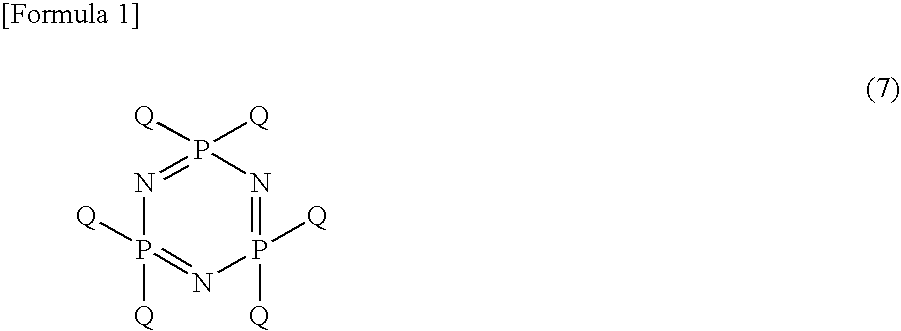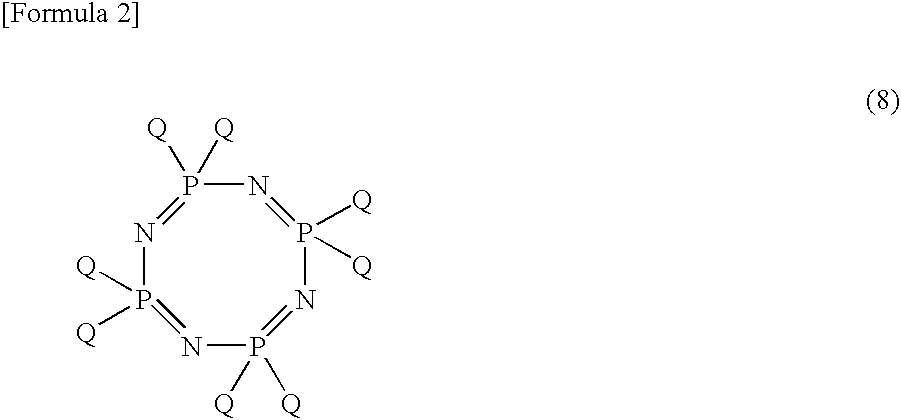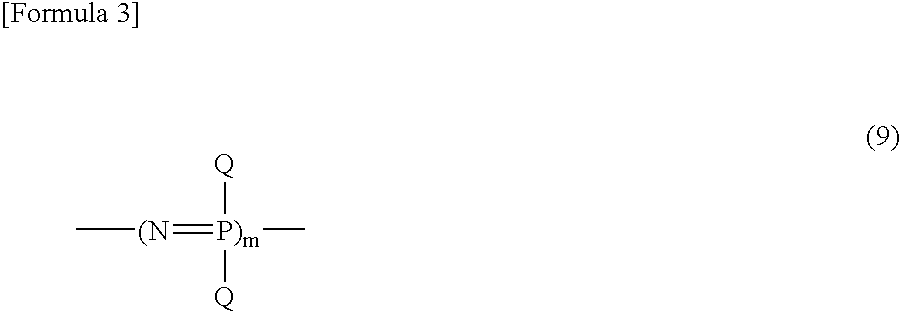Process For Producing Phosphonitrilic Acid Ester
- Summary
- Abstract
- Description
- Claims
- Application Information
AI Technical Summary
Benefits of technology
Problems solved by technology
Method used
Image
Examples
example 1
[0157] 7.05 g (0.075 mol) of phenol, 2.76 g (0.069 mol) of sodium hydroxide, 0.35 g (0.0062 mol) of potassium hydroxide and 30 g of o-dichlorobenzene were put in a 200 ml four-neck flask equipped with a stirrer, a condenser, a dropping funnel and a thermometer. Sodium phenoxide and potassium phenoxide were prepared by azeotropic dehydration under nitrogen flow at an oil bath temperature of 190° C. 3.63 g (0.031 mol) of synthesized phosphonitrile dichloride dissolved in 25 g of o-dichlorobenzene was added dropwise thereto over 15 minutes. Part of the reaction solution was collected by a microsyringe and the moisture content was measured. As a result, the moisture content was 0.010 mole based on 1 mole of phosphonitrile dichloride. Subsequently, heating was performed at an oil bath temperature of 175° C. The reaction was followed by HPLC and terminated 4 hours after the reaction system reached 170° C. (hereinafter the same). After completion of the reaction, the reaction solution was ...
example 2
[0158] 7.05 g (0.075 mol) of phenol, 2.76 g (0.069 mol) of sodium hydroxide, 0.93 g (0.0062 mol) of cesium hydroxide and 30 g of o-dichlorobenzene were put in a 200 ml four-neck flask equipped with a stirrer, a condenser, a dropping funnel and a thermometer. Cesium phenoxide and sodium phenoxide were prepared by azeotropic dehydration under nitrogen flow at an oil bath temperature of 190° C. After cooling to room temperature, 3.63 g (0.031 mol) of synthesized phosphonitrile dichloride dissolved in 25 g of o-dichlorobenzene was added dropwise thereto over 15 minutes. Part of the reaction solution was collected by a microsyringe and the moisture content was measured. As a result, the moisture content was 0.018 mole based on 1 mole of phosphonitrile dichloride. Subsequently, heating was performed at an oil bath temperature of 175° C. The reaction was followed by HPLC and terminated 3 hours after the reaction system reached a reflux state. After completion of the reaction, the reaction ...
example 3
[0159] 7.05 g (0.075 mol) of phenol, 2.76 g (0.069 mol) of sodium hydroxide, 0.35 g (0.0062 mol) of potassium hydroxide and 20 g of xylene were put in a 200 ml four-neck flask equipped with a stirrer, a condenser, a dropping funnel and a thermometer. Sodium phenoxide and potassium phenoxide were prepared by azeotropic dehydration under nitrogen flow at an oil bath temperature of 150° C. After cooling to room temperature, 0.015 g (0.05 mmol) of (NH4)3ZnCl5 prepared was added thereto and 3.63 g (0.031 mol) of synthesized phosphonitrile dichloride dissolved in 20 g of xylene was added dropwise thereto over 15 minutes. Part of the reaction solution was collected by a microsyringe and the moisture content was measured. As a result, the moisture content was 0.014 mole based on 1 mole of phosphonitrile dichloride. Subsequently, heating was performed at an oil bath temperature of 150° C. The reaction was followed by HPLC and terminated 8 hours after the reaction system reached a reflux stat...
PUM
 Login to View More
Login to View More Abstract
Description
Claims
Application Information
 Login to View More
Login to View More - R&D
- Intellectual Property
- Life Sciences
- Materials
- Tech Scout
- Unparalleled Data Quality
- Higher Quality Content
- 60% Fewer Hallucinations
Browse by: Latest US Patents, China's latest patents, Technical Efficacy Thesaurus, Application Domain, Technology Topic, Popular Technical Reports.
© 2025 PatSnap. All rights reserved.Legal|Privacy policy|Modern Slavery Act Transparency Statement|Sitemap|About US| Contact US: help@patsnap.com



